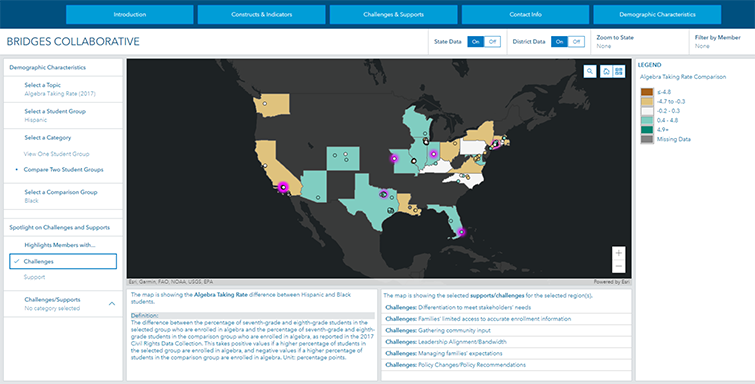Bridges Collaborative Continuous Improvement Study

Among policymakers, educators, and communities across the U.S., there is renewed discussion and debate on race- and income- based school segregation. Today, educational scholars argue that current levels of segregation and racial isolation of students in many metropolitan areas mirror those levels occurring in the 1960s and 1970s when desegregation policies were first implemented.
A wide range of factors has driven this increase in school segregation. They include shifting demographics and living patterns, increases in public school enrollment by Black and Latino families as white enrollment declines, and local efforts to resist integration, including gerrymandering of school district boundaries and school district secession. Among these factors, residential segregation remains a primary driver.
The Bridges Collaborative
The Bridges Collaborative provides a unique opportunity to explore desegregation and integration efforts in diverse contexts and address some of the gaps in the research. An initiative of The Century Foundation (TCF), the Bridges Collaborative is a coalition of various collaborators, describing itself as a grassroots initiative to advance racial and socioeconomic integration and equity in U.S. schools. Institutions and organizations invested in school integration are invited to apply to the Bridges Collaborative to participate in a capacity-building and peer learning experience.
The objective of the Bridges Collaborative is to serve as a hub where school, housing, and community development leaders learn from one another as they develop approaches for school integration and build grassroots momentum. To accomplish these goals, the Bridges Collaborative aims to:
- Foster collaboration among teams of school partners that are pursuing desegregation and integration in their locales;
- Provide strategic support to practitioners; and
- Influence the national dialogue on school desegregation and integration.
The inaugural cohort of Bridges Collaborative members features 57 organizations, including 27 school districts, 17 charter schools, and 13 fair housing organizations. Together, these entities represent more than 3.5 million children across the U.S., and the reach of the Collaborative spans more than 20 states.
The Continuous Improvement Study
AIR is seeking both to address gaps in the research and to serve the needs and interests of Bridges Collaborative members. Our study provides contextual data about strategies used by its members and facilitators.
The purpose of the study is to:
- Produce insights to help understand the conditions associated with school desegregation and integration;
- Describe lessons learned from the lived experiences of Bridges Collaborative members;
- Develop guidance and promising practices for engaging collaborators in future efforts; and
- Inform the capacity-building efforts of The Century Foundation to support the needs of Bridges Collaborative members.
Research Methods
The team is using a mixed methods approach to data collection that included: a) extant data collection (school and neighborhood demographics, school climate data); b) artifact collection; c) interviews and focus groups; and d) surveys.
Deliverables
AIR is developing deliverables to provide context on the Bridge Collaborative work and member locales, and to highlight promising practices to reducing school segregation and increasing integration. All deliverables are expected to be released by February 2023.
Member Profiles (PDF)
- Bridges Collaborative Member Profiles are designed to provide overviews of both successful efforts that have met their self-defined goals and those that faced significant barriers, including information about local context, actions taken, and key partnerships involved.
- The Indicators Report is designed to introduce readers to the status of desegregation and integration efforts in American schools, define the role of Bridges Collaborative member organizations within these efforts, and share some beginning foundational concepts to help districts and schools around the country effectively plan, implement, and sustain this work.
- The Member Characteristics provide an overview of Bridges Collaborative member locales and contexts. The analysis present disaggregated summaries of demographic dissimilarity, chronic absenteeism, AP course taking for high school students, Gifted programming referrals for elementary and middle school students, and exclusionary discipline data.
Interactive Map Tool

The Interactive Map Tool synthesizes findings of this study into a user-friendly format for practitioners and researchers, allowing access to contextual insights adjacent to the work of the Bridges Collaborative members. Included are geographic-based reports and best practices highlights disaggregated to the district and state levels.
Explore this how-to guide to learn more about Interactive Map features and content.
Theory of Change
With support from the AIR Equity Initiative, a group of staff from across AIR conducted landscape scans of residential mobility studies, examined policies and local investments in communities, and reviewed the history of and responses to community and school segregation. The working group also identified gaps in the research and technical assistance related to school desegregation and integration efforts.
These efforts underscored the need for theories of change that reflect system level connections in the design, implementation, and evaluation of efforts to advance equity. Theories of change provide explicit statements of how programs, policies, and practices operate to contribute to desired effects. They surface key assumptions and set the stage for quality design of interventions and evaluations.
The working group developed a tool to equip researchers and technical assistance providers at AIR and elsewhere to conceptualize the link between residential and school segregation and how to respond. The tool was designed to further encourage how systems, their elements, context, and interconnections may aid or hinder change.
Please watch this video for a brief introduction to the theory of change.
